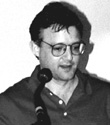
| T H E N I H C A T A L Y S T | M A Y - J U N E 1 9 9 8 |
CULTURE CLASHES REVISITED: |
by Fran Pollner |
AT LEAST TWO SIDES TO TWO TALESLAMB STEW | |
Publications like Science and Nature typically send out "tip sheets" a week in advance of each issue's publication, alerting science reporters to the upcoming contents. Reporters can request the full paper and conduct interviews but cannot print anything until the journal's publication date. The language describing the Ian Wilmut paper in the Nature tip sheet was low-keyed and somewhat obscure, but to Kolata the words "derived from adult tissue" were a call to action.

Gina Kolata
|
She called Scotland and prepared a story that would be ready to go in case anyone broke the embargo-which a small British newspaper, The Observer, did in a roundabout way: It did not allude to the Nature report but presented enough of the Dolly plot to undo the embargo. The New York Times got the story onto the first page of its second edition the next day; by the time the third edition rolled out, the story had taken lead position (upper right) on the first page, overtaking the political piece on Democratic tax policies that earlier had held the top spot.
Kolata's journalistic judgment led her to decline to report on several subsequent would-be cloning stories after she concluded they lacked validity. One such a piece involved an outfit called Clonaid whose representatives claimed they had scientists all over the world working quietly in their labs to clone dying people for private clients. Another story she dismissed was the announcement by Chicago-based physicist Richard Seed that, presidential proclamations notwithstanding, he planned to proceed with human cloning in the treatment of infertile couples-abroad if necessary. Determining that Seed was an "unemployed physicist in debt," Kolata decided not to pursue the story. It was broken, instead, by National Public Radio's Joe Palca, who reckoned that Seed "wouldn't need the expertise, per se, just the interest of those who do have it." Palca had done a Medline search on Seed, found one fertility-related article, and was told by Seed during a telephone interview that he'd made a deal with an embryologist and a gynecologist, had clients who were good candidates, and might go overseas to do the work. "It seemed newsworthy," Palca said.

Joe Palca
|
"Once I heard about Joe's story, I had 30 minutes to decide what to write," Kolata said, explaining how some of the "news that's fit to print" gets into print. "Once there's competitive pressure, we have to cover it. What others are doing, what people want to hear about, that's what dictates what gets onto the pages of the New York Times."
In an exchange that displayed the disconnect between the scientific and news communities-or at least some of their members-panelist Carol Greider, a Johns Hopkins University molecular biologist and geneticist and a member of the National Bioethics Advisory Commission, expressed her astonishment at the publicity generated by Dolly. "We basic scientists had a different reaction from the general public. What's the big deal? We couldn't figure it out. One animal touted as a breakthrough made our jaws drop."
Kolata responded: "Dolly was proof of concept! The whole idea of cloning humans
from adult cells has been part of the scientific imagination and sci-fi horrors
for decades." To which Greider replied: "There really is only one sheep Dolly.
I'm skeptical until it's reproducible." At which point Palca exclaimed: "It's
stunning because it contravenes the fundamental tenet that a differentiated
cell can't go back." "No," Greider said, "it was just the next step, not that
revolutionary, not that big a leap."
Quotables?The first chapter of Gina Kolata's book [Clone: The Road to Dolly and the Path Aheaed] "will drive scientists crazy," promised bioethicist Robert Cook-Deegan, director of the National Cancer Policy Board of the National Academy of Sciences. "It's a compilation of outrageous statements from scientists and bioethicists who wanted to be on the front page of the New York Times- and they succeeded." |
|